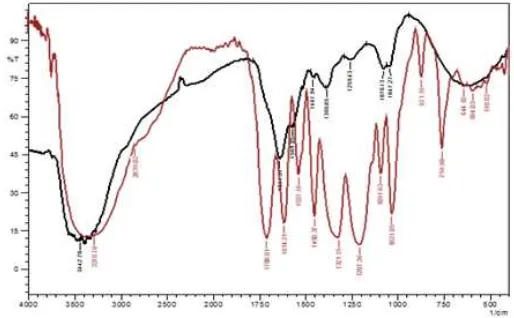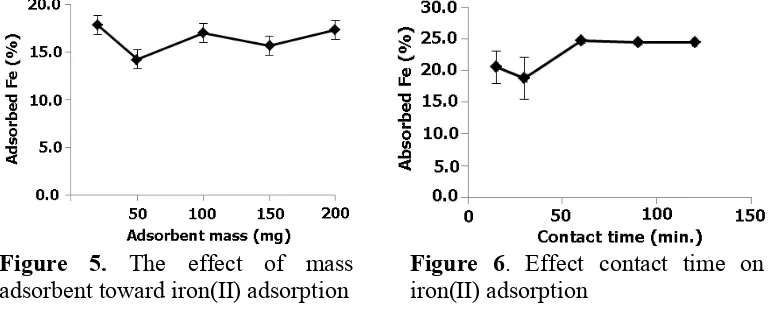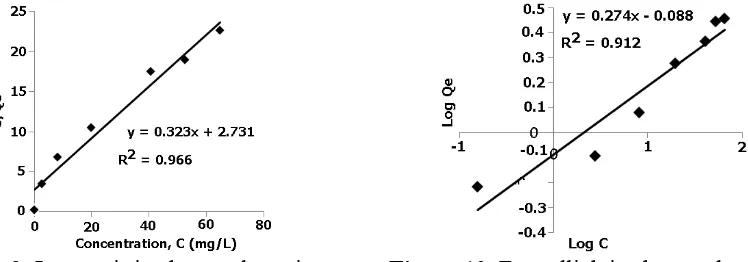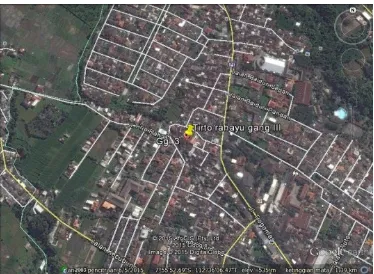The journal homepage www.jpacr.ub.ac.id p-ISSN : 2302 – 4690 | e-ISSN : 2541 – 0733
Immobilized Tannin from
Sanseviera trifasciata
on Carbon as
Adsorbent For Iron(II) in Polluted Water
Irfan H. Arif1,2, Barlah Rumhayati2, Masruri MASRURI2*
1
Madrasah Aliyah Mareku, Jl. Raya Rom Suwasiu Kelurahan Mareku, Tidore Utara, Kota Tidore Kepulauan, Indonesia
Chemistry Department, Brawijaya University, Jl. Veteran 65145 Malang, Indonesia
Corresponding email: masruri@ub.ac.id , irfanharif@ymail.com Tel. +62 341 575838, Fax. +62 341 554403
Received 10 February 2016, Revised 14 March 2016, Accepted 14 March 2016
ABSTRACT
The organic-agricultural waste resulted from local farmer or community gardening recently paid public attention. The presence and easily grow of “Lidah Mertua” or Sanseviera trifasciata being focus investigation for its prospecting application. It was reported that the leaves contain some phenolic compound including tannin from aqueous extraction. This paper revealed recent investigation application of isolated tannin from leave part for modification of carbon. The previous paper published that carbon was able to adsorb some toxic heavy metals. However, it has some limitation including lower capacity adsorption. Impregnation of tannin-isolated from S. trifasciata leaves was proposed able to improve the carbon functionality, physical appearance, pores size, and its adsorption capacity. Our investigation discloses that modified carbon with tannin was able to adsorb iron(II) between 14-18% of its weight. It activity improved to 20% adsorption for 30 min shaking. The working pH adsorption ranges between 3 and 8, and the optimum adsorption is reached after pH 6 (above 60% adsorption occurred). The Langmuir and Freundlich adsorption mechanism model also disclosed that mechanism of iron(II) adsorption on the adsorbent tannin-immobilized on carbon. The real test using community well drilling water source also gave an important finding on the concentration of iron(II) contained on water source even sample is taken from the single side.
Keywords: Sansevieria trisfasciata, tannin, adsorbents, adsorption, iron(II)
INTRODUCTION
Water is an important element for human life. It contains a small amount of mineral or metal in acceptable quantity. However, increasing industrialization in Indonesia some heavy metals leaching from industrial and community area contaminates the water sources [1–3]. For example iron contaminated water sources in the river and community well [3,4]. Some methods have been developed in order to reduce excessive iron contained in water source [5,6]. For example, by applying adsorption [3,7], precipitation [8], evaporation, and electrochemistry techniques [9]. However, these methodologies are generally not suitable for local development priority.
Tannin isolated from Moringa seed had been used to coagulate iron(III) contaminated on community water source [16]. This technique improves water quality from community well by 44.60% and 55.32% from industrial wells. Another report also applies tannic acid in pure grade to adsorb some heavy metals ions such as copper, cadmium, zinc, manganese, and iron [18]. For example, it was able to adsorb copper(II) by 5.4% between 3.0 and 6.0 pH range. This is a very broad range pH that usually compatible with the sample from industrial and domestic liquid wastes.
Regarding the recent strategy that tannin and or tannic acid is naturally able to be extracted from plant, this paper applied tannin isolated from local plant biomass, S. trifasciata, that is widely grown by local farmer and family gardeners [19,20] for iron(II) adsorption. Isolation was undertaken by extraction technique and analysis was conducted by spectrophotometry [21,22]. The isolated tannin was impregnated on activated carbon and was evaluated the capability to absorb the iron(II) from polluted local water sources.
Figure 1. (right) Plant of S. trifasciata grown as home garden
EXPERIMENT
Chemicals and instruments
Chemicals for research was bought from manufacturer and used directly without pre-treatment (as mentioned) include acetone (SAP), methanol (SAP), ethanol (SAP), tannic acid (Sigma), hydrochloric acid (Merck), carbon black, iron(II)sulfate (Merck), sodium hydroxide (Merck), nitric acid (JT Baker), and potassium bromide (Merck). Meanwhile, some main instruments operated for adsorbent preparation and analysis includes rotary evaporator (Buchi), spectrophotometer UV-Vis (Shimadzu UV-VIS), FTIR spectrophotometer (Shimadzu FTIR), atomic adsorption spectrophotometer (Shimadzu Shimadzu AA-620), and scanning electron microscope (Hitachi TM 3000 with Swifted 3000 X-ray microanalysis).
Tannin extraction and analysis
Extraction of tannin following reference [21]. A 50 g of fresh of S. trifasciata was added by 30 mL distillated water and crushed in juice processor to obtain S. trifasciata juices. It was transferred to erlenmeyer and added with 70 mL acetone. This mixture was homogenized using magnetic stirrer for 60 minutes. Then, the mixture was filtered through Buchner separator funnel and the filtrate afforded was collected as tannin extract. This extract was analyzed its tannin contents using UV-Vis and FTIR spectrophotometer, and the resulted tannin was applied to activate carbon.
Immobilized tannin on carbon
105 oC for 3 h and was kept dry on desiccator [23]. This acidic-activated carbon (20 g) in glass beaker was added with 50 mL of tannin solution 5.0 ppm and added buffer solution to reach pH 4. This mixture was stirred for an hour and further separated by centrifugation at room temperature. The resulted solid phase was washed with distilled water and dried in oven at 105 oC until constant weight [18]. The product was carbon-immobilized tannin and further analysis and applied to study.
Adsorption
Solution 20 ppm of iron(II)sulfate 25 mL each (5 samples) was added with 20, 50, 100, and 200 mg of prepared adsorbent. Each mixture was further shaken at 100 rpm at room temperature for an hour. The mixture was separated by filtration and the filtrate was analyzed the remaining iron(II) contents by atomic absorption spectrophotometer. The procedure was undertaken triplicates.
Effect shaking time on adsorption
75 ppm of iron(II)sulfate 25 mL each (5 samples) was added 100 mg of adsorbent. These were further shaken at 100 rpm different time, i.e. 15, 30, 60, 90, and 120 minutes. The result was filtered and the filtrate was analyzed the remaining iron(II) contents by atomic absorption spectrophotometer. Procedure was undertaken triplicates.
Effect pH condition on adsorption
Solution 75 ppm of iron(II)sulfate 25 mL each (9 samples) was adjusted the pH solution to pH 3.0, 3.5, 4.0, 4.5, 5.0, 5.5, 6.0, 7.0, and 8.0 by addition of sodium hydroxide or nitric acid solution 0.1 M. Then 100 mg of adsorbent was added and was further shaken at 100 rpm for an hour in room temperature. The result was separated by filtration and the filtrate was analyzed the remaining iron(II) content by atomic adsorption spectrophotometer. The procedure was performed triplicates.
Effect adsorbate concentration on adsorption
Solution 25 mL of iron(II)sulfate with different concentration each i.e. 3.00, 6.00, 12.0, 24.0, 50.0, 75.0, and 100 ppm was pH 4 was added adsorbent 100 mg. These were shaken at 100 rpm for an hour at room temperature. The result was separated by filtration and the filtrate was analyzed the remaining iron(II) content by atomic absorption spectrophotometer. The procedure was performed triplicates.
Analysis of water sample from local community
Water samples were taken from the local residential in Malang city, East Java, Indonesia (07o55’52.69”S 112o36’06.47” E) and kept in plastic bottles. The plastic container-contained sample was stored 4oC before further preparation. A 25 mL of water sample was transferred into glass beaker and adjusted to pH 5 and added 100 mg of adsorbent. This was shaken at 100 rpm in room temperature for 60 minute and the resulted mixture was separated by filtration. The filtrate resulted was analyzed by atomic absorption spectrophotometer. The procedure was undertaken triplicates.
Data analysis
percentage. The adsorbed iron(II) on carbon-immobilized tannin as adsorbent was calculated
Co is initial concentration of iron(II) solution (ppm or mg/L), Cs is concentration of iron(II) after adsorption process (ppm or mg/L). While the number of adsorbed iron(II) was (ppm or mg/L), Cs is concentration of iron(II) after adsorption process (ppm or mg/L), V is volume of solution (L), and M is mass adsorbent used in gram (g).
RESULT AND DISCUSSION Immobilized tannin on carbon
Carbon and modified carbon or functionalization carbon have been widely used for removal and cleaning water and water sources from polluted and toxic heavy metals [24–29]. Modification of the carbon structure can be undergone by treatment with acid and basic, or functionalization of the site active attached on the surface of carbon. Modification can also be prepared by modification of molecular architecture of carbon surface. For example nitrogen-doped carbon by addition of tannin during hydrothermal process [30], tannic acid modified on carbon [31,32]. Modification by functionalization with amine group [33], modified bamboo carbon by addition of humic acid [34], and modification by giving metal oxide such as iron oxide, aluminium oxide and titanium oxide [35]. This modification is required in order to afford special function of carbon for adsorption process or other water source purification.
This paper applied tannin extracted from agricultural waste plantation, S. trifasciata. This plant is easily grown in residential garden [36] or as home ornament [37], but also harvested by farmer due to economic benefit [38]. Tannin comprised in S. trifasciata, especially from leaves part contains condensed and hydrolyzed tannins. Extraction was performed based fresh leaves under water-acetone (30:70 v/v) and the result was further analyzed the presence of tannins by chemical reaction. Iron trichloride was applied to oxidize the phenolic groups of tannin by abstraction of hydrogen atom on hydroxyl group. Changing of solution color to red-brown is as an indication the presence of phenolic groups or tannin.
The infrared spectrophotometry analysis revealed the functional group of tannin such as hydroxyl (band 3400 1/cm), benzenoid-aromatics (band 1600 1/cm), and carbonyl or carboxyl-group (band 1700 1/cm). Comparing the resulted spectra to the standard of tannic acid, the functional group bands and fingerprint region bands give a similar feature. Even though both spectra slightly different in adsorption intensity, those correlate to the concentration (figure 2).
Immobilization of isolated tannin onto carbon black directly can be performed by mixing the isolated tannin solution in acetone-water (70-30 v/v) with acid-activated carbon 3for an hour at room temperature [18]. After drying process in oven at 105 oC, tannin impregnated on carbon as adsorbent was resulted (figure 3). The activated carbon was performed under acidic treatment with hydrochloric acid solution. The immobilized tannin on activated carbon displays a bright black color appears from image (figure 3.B) compare to that the activated one (figure 3.A). Further analysis the presence of tannin group on carbon indicated important results (figure 4).
Figure 3. (right)
Representative image for acid-activated carbon (A) and carbon-immobilized tannin from S. trifasciata (B)
Impregnation process goal is indicated by appended the tannin on activated carbon. The appearing of main functional groups of tannin in developed adsorbent determined the result. Hydroxyl-group of tannin recorded about 3400 1/cm and also its aromatic-benzenoid ring also found in around 1600 1/cm. Besides that, carboxyl-group around 1700 1/cm, and C-O groups was also observed on developed adsorbent (figure 4-middle). Activated carbon itself does not have these peaks adsorption on infrared spectra (figure 4-bottom). And this result concluded that tannin was successfully immobilized on activated carbon. Detailed tabulation is recorded in table 1.
Table 1. Tabulation of infrared spectra bands displayed on figure 4
Frequency (1/cm) Functional group Detected (1/cm) Sample [T], [M] and [B]
Note: T: spectra from tannin, M: middle spectra from tannin-immobilized on carbon, and B: bottom spectra from activated carbon in figure 4.
Effect of mass adsorbent on adsorption
The adsorbent quantity was studied to understand its capability to adsorbing the iron(II) on sample. A variation of mass adsorbent was designed as 20, 50, 100, 150 and 200 mg with a constant concentration of iron(II) model sample (20 ppm) and pH 4. The result is described in figure 5.
In overall, mass of adsorbent developed from tannin-immobilized on activated carbon was able to absorb iron ions. The percentage of the adsorbed for the given mass range was between 14 and 18%. The highest percentage was achieved by using 20 mg of adsorbent. It slightly decreased to about 14% using 50 mg of adsorbent. A relatively minor fluctuation value was resulted by increasing of mass adsorbent. This fact indicates the applied volume and concentration of adsorbent, giving the similar capability to absorb iron(II). The standard deviation of each value was also insignificant different. Thus, it concludes that mass variation already equilibrium.
Figure 5. The effect of mass adsorbent toward iron(II) adsorption
Figure 6. Effect contact time on iron(II) adsorption
Effect of contact time of adsorbent on adsorption
In general, the percentage of iron(II) was adsorbed was about 17-20% during 15 to 30-minute study. The improvement was recorded after 60-30-minute interaction between developed adsorbent and iron(II) model sample. It reached to about 25% of iron(II) was adsorbed. The rest of time, it slightly gave a similar result. The standard deviation calculated also did not give any significant different toward iron(II) adsorbed. Thus, this finding outline that contact time effectively for iron(II) adsorbent by using developed adsorbent, tannin-immobilized on carbon, is 60 minute and the percentage of iron(II) adsorbed is about 25% by using 100 mg adsorbent, stirring at 100 rpm and constant pH at 4.
Effect of pH condition on iron(II) adsorption
Metal ion adsorption on carbon surface or in the carbon pores is not always undergoing physical adsorption. Interaction with some functional groups such as hydroxyl (OH), carboxyl (COO), carbonyl (C=O), and amine (NH) group theoretically improve the adsorption capability [41]. Modification of carbon by tannin which is rich in functional groups of phenolic, carboxylic acid and hydroxyl-groups increase the functional activity [14]. However, the activity of these functional groups is affected by acidic or basicity of the adsorption conditions. Generally, for hydroxyl, carboxyl and phenolic group will increase its ionic properties by increasing the basicity [42,43]. Thus, these groups more giving the active interaction with metal ions in basic conditions rather than those in acidic.
The study applied pH range from 3 to 8 and 100 mg of tannin-immobilized on carbon was mixed with 25 mL of iron(II) solution (75 ppm) with constant stirring (100 rpm) in room temperature (figure 7). The acidic pH (between 3 and 6), a slight improvement in iron(II) adsorption occurred. The rough percentage calculated was between 5 and 20%. It sharply improved after pH above 6. Applying of the pH to 6.5-7.0 gave a higher iron(II) adsorption (55-90%). However, at some point, some paper reported that iron(II) was able to solidify and form iron(II) hydroxide at pH above 6. But, this finding underlines the potency of tannin-immobilized on carbon as iron(II) adsorbent.
Figure 7. Effect of pH conditions on iron(II) adsorption
Figure 8. Effect of initial concentration of iron(II) on its adsorption
Effect of mass adsorbate on iron(II) adsorption
was studied in increasing quantity from 3.00, 6.00, 12.0, 24.0, 50.0, 75.0 and 100 mg/L or ppm. The contact time applied was 60 minute and mass adsorbent 100 mg, stirring at 100 rpm and pH 4. The result is displayed in figure 8.
The general view was found that increasing of iron(II) concentration also affects significantly the number of iron(II) adsorbed onto the adsorbent. All of the result values gave the significant different number on statistical analysis. Applying initial concentration about 3.00 ppm, gave 0.600 mg/g of iron(II) adsorbed in the adsorbent. The value steeply improved to about 1.80 mg/g for 24.0 ppm. A relative constant number was afforded after concentration above 75 ppm is applied. It gives adsorption to about 2.80 mg/g.
Equilibrium adsorption mechanism
Understanding the mechanism adsorption of iron(II) model substrates into developed adsorbent tannin-immobilized on carbon, the Langmuir, and Freundlich isotherm model was applied. The study is undertaken at constant temperature (29 oC). Langmuir model assumes irreversible homogeneous layer adsorption occur and the substrate or iron(II) was adsorbed into one adsorption site and all the site adsorption was identical. And as a result, affinity of each molecule adsorbate toward the adsorbent site was similar by giving similar a constant enthalpy including activation energy for adsorption [45]. On the other hand, Freundlich isotherm equilibrium model applied different approach to a heterogeneous surface and non-identical or similar adsorption site of adsorbent. The model more applicable to that multilayer adsorption phenomena although with different affinity of adsorbent site on adsorbent surfaces [44].
Figure 9. Langmuir isotherm adsorption Figure 10. Freundlich isotherm adsorption
Table 2. Langmuir and Freundlich isotherm adsorption parameter Langmuir Isotherm Isoterm Freundlich Isotherm Qmax (mg/g) = 3.09 Kf = 0.82
b (L/mg) = 0.12 n = 3.64 R2 = 0.9661 R2 = 0.9127
0.912, (figure 10). The Freundlich constant is 0.82 and 3.64 for its heterogeneity factor (table 2).
Comparing both results that Langmuir model adsorption was more linear that may acceptable to describing mechanism adsorption of iron(II) by adsorbent tannin-immobilized on carbon. It occurred in the homogeneous site with single layer model adsorption. Thus chemisorption probably more favor rather than physical adsorption. Thus, the presence tannin inside or sitting on activated carbon improved it capacity adsorption process and chemically modified the surface of carbon. Some phenolic, hydroxyl, and carboxylic acid group on tannin played an important role to activate the adsorption of carbon.
Figure 11. SEM image of activated carbon (left) and tannin-immobilized on it (right)
Figure out of the adsorbent surface was monitored under scanning electron microscope (SEM) both for carbon itself and tannin-immobilized on carbon (figure 11). The activated carbon appears as condensed layers and with no pores contained. Some small dots observed in each layer as a closed-cavity inside the layer. On the other hand, the developed adsorbent immobilized tannin gave large pores and the structure contained more space inside the pores of the carbon. This possibly makes tannin dock inside the pore to improve the adsorption capacity.
Figure 12. Sampling location from community well drilling area
analysis applied 100 mg adsorbent with 60 minutes shaking at 100 rpm and optimum pH. It discloses that the iron(II) comprised in water source about 2.66 ppm (table 3) and this value is above the standard as water source for consumption prior treatment by Ministry of Health, Republic Indonesia (Permenkes RI No. 492/Per/IV/2010). The iron contains must below 0.3 ppm to require the minimum standard as water source A grade.
Table 3. Iron(II) concentration adsorbed by developed adsorbent FeIntial concentration
To summarized, the developed adsorbent of carbon-immobilized tannin isolated from agricultural waste, S. trifasciata leaves, were able to be applied as adsorbent for iron(II) adsorption. The adsorbent main actives functional group was phenolic, hydroxyl, and carboxylic acid that generated from tannin functional group. Moreover, tannin-impregnated on carbon seems able to modify the pore size of carbon and this improved capability to absorb. The real application of adsorbent could be used to absorb the iron(II) from community well drilling water source.
ACKNOWLEDGMENT
Authors declare that no conflicts of interest and all authors have an equal contribution preparing the manuscript. IHA collects the data, BR evaluates the adsorption data, and MSR evaluates the tannin data and writing manuscript.
REFERENCES
[1]. Costa, D., Burlando, P., Priadi, C. Sustain. Cities Soc. 2016, 20, 199–209.
[2]. Huang, C., Ishikawa, S., Kabasawa, K., Morimoto, M., Motoshima, N., Ogata, S., Huang, J., Haraguchi, K. Sustain. Environ. Res. 2015, 25 (4).
[3]. Irawan, C., Atikah, A., Rumhayati, B. J. Pure Appl. Chem. Res. 2014, 3 (3), 88–98. Passivation/Deposition in Electrochemical Treatment Methods – A Case Study on Winery Wastewater with Electrocoagulation, Modern Electrochemical Methods, Dr. M. Aliofkhazraei (Ed.), InTech, In Modern Electrochemical Methods in Nano, Surface and Corrosion Science, 2014, pp 202–238.
[10]. Aaby, K., Mazur, S., Nes, A., Skrede, G. Food Chem. 2012, 132 (1), 86–97. [11]. Perera, P., Ekanayake, S., Ranaweera, K. Procedia Chem. 2015, 16, 519–524.
[13]. Shiddiqi, Q. Y. A., Karisma, A. D., Machmudah, S., Widiyastuti, W., Nurtono, T., Winardi, S., Wahyudiono, W., Goto, M. IPTEK. 2015, 25 (2), 54–57.
[14]. Iglesias, J., De Saldaña, E. G., Jaén, J. Hyperfine Interact. 2001, 134 (1), 109–114. [15]. Lavin, S. R., Chen, Z., Abrams, S. A. Zoo Biol. 2010, 29 (3), 335–343.
[16]. Prasetyaningtyas, F. U., Rumhayati, B., Masruri, M. J. Pure Appl. Chem. Res. 2013, 2 (3), 122–125.
[25]. Jain, M., Garg, V., Kadirvelu, K., Sillanpää, M. Int. J. Environ. Sci. Technol. 2016, 13 (2), 493–500.
[34]. Zhang, Y.-J., Ou, J.-L., Duan, Z.-K., Xing, Z.-J., Wang, Y. Colloids Surf. Physicochem. Eng. Asp. 2015, 481, 108–116.
[35]. Abussaud, B., Asmaly, H. A., Saleh, T. A., Gupta, V. K., Atieh, M. A. J. Mol. Liq. 2016, 213, 351–359.
[36]. Mediastika, C. E., Binarti, F. Sci. J. Riga Tech. Univ. Environ. Clim. Technol. 2013, 11, 19–27.
[37]. Sihombing, M. A. L., Rohie, A. M. C., Februyani, N., Swandayani, R. E. JITODE, 2015, 3 (1), 19–24.
[38]. Arifin, H. S., Kaswanto, R. L., Nakagoshi, N. In Designing Low Carbon Societies in Landscapes, Springer, 2014, pp 129–143.
[39]. Lu, A., Zhang, S., Shan, X. Geoderma 2005, 125 (3), 225–234.
[40]. Yang, S., Li, J., Shao, D., Hu, J., Wang, X. J. Hazard. Mater. 2009, 166 (1), 109–116. [41]. Reddad, Z., Gerente, C., Andres, Y., Le Cloirec, P. Environ. Sci. Technol. 2002, 36 (9),
2067–2073.
[42]. Jia, Y., Xiao, B., Thomas, K. Langmuir 2002, 18 (2), 470–478.







